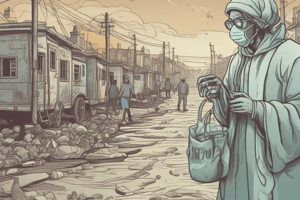Podcast
Questions and Answers
What is one of the primary benefits of food safety measures?
What is one of the primary benefits of food safety measures?
- Promotes the consumption of raw foods
- Increases the likelihood of food spoilage
- Prevents the growth of harmful bacteria (correct)
- Reduces the nutritional value of food
What religious dietary restriction is related to concerns about Trichinella-infected pigs?
What religious dietary restriction is related to concerns about Trichinella-infected pigs?
- Prohibition of shellfish
- Restriction on dairy products
- Ban on eating pork (correct)
- Avoidance of beef
Which approach was developed to enhance food safety for space travel?
Which approach was developed to enhance food safety for space travel?
- Food Quality Compliance (FQC)
- Quality Assurance Program (QAP)
- Hazard Analysis and Critical Control Point (HACCP) (correct)
- Total Quality Management (TQM)
How many Canadians are estimated to get sick from contaminated food each year?
How many Canadians are estimated to get sick from contaminated food each year?
What role does technology play in food safety?
What role does technology play in food safety?
What was the primary health issue caused by melamine in the 2008 poisoning incidents in China?
What was the primary health issue caused by melamine in the 2008 poisoning incidents in China?
How many confirmed cases of listeriosis were linked to Maple Leaf Foods in 2008?
How many confirmed cases of listeriosis were linked to Maple Leaf Foods in 2008?
What food item was implicated in the second-deadliest foodborne illness outbreak in U.S. history in 2011?
What food item was implicated in the second-deadliest foodborne illness outbreak in U.S. history in 2011?
What was the main cause of the E.coli outbreak reported in recent European history?
What was the main cause of the E.coli outbreak reported in recent European history?
Which scientist is credited with developing germ theory and introducing pasteurization in the 1860s?
Which scientist is credited with developing germ theory and introducing pasteurization in the 1860s?
What preservation method dates back 4,500 years due to its effectiveness?
What preservation method dates back 4,500 years due to its effectiveness?
What was an early method used for food preservation before refrigeration was commonplace?
What was an early method used for food preservation before refrigeration was commonplace?
What significant change occured in the late 1800s that impacted kitchen sanitation?
What significant change occured in the late 1800s that impacted kitchen sanitation?
What event is considered the first truly global disease outbreak?
What event is considered the first truly global disease outbreak?
During which conflict did 1,000 soldiers die from spoiled canned meat?
During which conflict did 1,000 soldiers die from spoiled canned meat?
What was a significant contributing factor to the 1985 Listeriosis outbreak?
What was a significant contributing factor to the 1985 Listeriosis outbreak?
Which outbreak involved the largest peanut butter-related salmonella incident in U.S. history?
Which outbreak involved the largest peanut butter-related salmonella incident in U.S. history?
The second cholera pandemic led to approximately how many deaths in the U.S.?
The second cholera pandemic led to approximately how many deaths in the U.S.?
What was the primary cause of the 1927 Typhoid Epidemic in Montreal?
What was the primary cause of the 1927 Typhoid Epidemic in Montreal?
What was the result of the Hepatitis A outbreak in Chi-Chi’s restaurant?
What was the result of the Hepatitis A outbreak in Chi-Chi’s restaurant?
Which outbreak was characterized by a total of 403,000 people becoming ill?
Which outbreak was characterized by a total of 403,000 people becoming ill?
Flashcards are hidden until you start studying
Study Notes
Cholera Pandemics
- First Cholera Pandemic (1817-1823): Triggered by contaminated rice in India; spread globally through British military and trading routes; death toll remains unknown.
- Second Cholera Pandemic (1830-1851): Worst outbreak of the 1800s; originated in India and spread worldwide; brought to the U.S. by settlers, causing approximately 150,000 American deaths.
Foodborne Illness Outbreaks
- Botulism (1896): Poor canning methods led to more deaths from spoiled canned meat during the Spanish-American War than combat (1,000+ deaths).
- Typhoid Epidemic (1927): Caused by raw milk; 533 deaths reported in Montreal; led to mandatory pasteurization in Ontario by 1938.
- Listeriosis Outbreak (1985): Resulted from tainted cheese; affected 142, with 52 deaths; significant legal consequences for the company involved.
- E. coli O157 Outbreak (1993): Infections linked to undercooked "Monster Burgers," affecting 732 and causing 4 deaths; nearly bankrupted Jack in the Box.
- Cryptosporidium Outbreak in Milwaukee (1993): Contaminated water caused around 403,000 illnesses and over 100 deaths, marking the largest waterborne outbreak in U.S. history.
- Salmonellosis Outbreak (2008): Largest peanut butter-related outbreak in history, resulting in 9 deaths and over 714 illnesses; severe economic impact on the Peanut Corporation of America.
- Hepatitis A Outbreak (2003): Originated from tainted green onions at a Chi-Chi’s restaurant; affected 640 individuals with 4 fatalities.
International Food Safety Incidents
- Melamine Poisoning (2008): Contaminated baby milk powder in China led to over 300,000 illnesses; associated with 6 infant deaths.
- Listeriosis Outbreak (2008): Cold cuts from Maple Leaf Foods resulted in 57 cases and 22 deaths; recall cost around $20 million.
- Cantaloupe Outbreak (2011): 147 infected and 33 dead due to Jensen Farms’ cantaloupes shipped to 25 states; company recalled the entire crop.
- E. coli Outbreak (2011): Caused by fenugreek sprouts in Germany; 3,950 infections and 53 deaths, making it one of Europe's worst food poisoning events.
Historical Food Safety Practices
- Prehistoric Approaches: Early humans likely avoided spoiled food; learned by experience similar to animals’ instincts.
- Food Preservation Methods: Included fermentation, salting, dehydration, and early refrigeration techniques via iceboxes.
- Refrigeration's Evolution: James Harrison patented a vapor-compression refrigerator in 1855, greatly extending food shelf life and safety.
Religious and Space Influences on Food Safety
- Religious Guidelines: Old Testament dietary laws prohibiting pork linked to health concerns, notably Trichinella risk.
- Impact of Space Travel: Development of HACCP by Pillsbury and NASA for food safety hazard management.
Food Safety in Canada
- Current Status: Canada maintains one of the safest food supplies globally; however, approximately 4 million annually suffer from foodborne illnesses.
- Government Responses: Outbreaks have spurred enhancements in food safety legislation and public health approaches.
- Shared Responsibility: Food safety requires a collective effort from individuals and institutions.
Studying That Suits You
Use AI to generate personalized quizzes and flashcards to suit your learning preferences.





